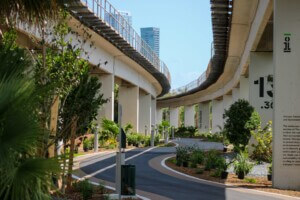What goes into a park? We dug into the parts and pieces of landscape design to explore and illustrate the forces, material histories, and narratives that hide beneath the surface. This article is the first of three such deep dives, which includes Tongva Park in Santa Monica, California, and The Gathering Place in Tulsa, Oklahoma. All illustrations were done by Adam Paul Susaneck.
The transformation of Hunter’s Point South in two phases from a contaminated strip of coast in Long Island City, Queens, to an ecologically sensitive 11-acre park was 11 years in the making. Stretching along the East River south of Gantry Plaza State Park and Steven Holl’s Hunter’s Point Community Library (see page 16), Hunter’s Point South Park sits on a conveniently sited piece of land that was neglected for decades before the park opened at the end of last year.
The park was designed by Thomas Balsley Associates (TBA; the firm became SWA/Balsley in 2016) and WEISS/MANFREDI to be a sustainable storm buffer and public green space for the new Hunter’s Point South development, a 5,000-unit housing complex on the southern shore of Long Island City.
The idea for Hunter’s Point South Park had been percolating long before plans for it officially started coming together in 2007. Thomas Balsley told AN that back in 1990, when Gantry Plaza State Park was being planned, he envisioned a whole-coast master plan that would stretch from Anable Basin in Long Island City (the site of Amazon’s failed HQ2 bid) all the way down to Newtown Creek in Greenpoint, Brooklyn (now home to a wastewater treatment plant known for its iconic “biodigester” eggs). To Balsley, Gantry Plaza State Park was supposed to be the start of a line of parks running down the Queens–Brooklyn shore. Design on Hunter’s Point South Park began in 2009, and Balsley and Weiss/Manfredi’s early sketches are remarkably close to what would be built nine years later.
The linear park provides views of the Manhattan skyline and has an amphitheater-like arrangement that also blocks noise from the busy Queens streets to the east. Because of tight siting requirements, budget constraints, and the harsh microclimate that the park has to endure, SWA/Balsley filled the site with resilient native salt-marsh plants. Besides acting as a natural flood buffer, the plants don’t require active irrigation, meaning none was built into the site. The plants also filter and clean the river, a job that Balsley likened to “acting as the park’s liver.”

Lighting
Arup was also responsible for specifying the park’s lighting fixtures. Most of the fixtures used were New York City Department of Transportation/Parks Department–standard pedestrian- and street-lighting poles and Holophane helm fixtures. Linear lighting by Wagner was used to illuminate the benches and overlook handrails and as uplighting. Step lights by Bega were integrated into the wooden furnishings and concrete walls. The nonstandard lighting features were all intended to be as minimal and unobtrusive as possible, so as not to detract from the landscape and views.
Structures
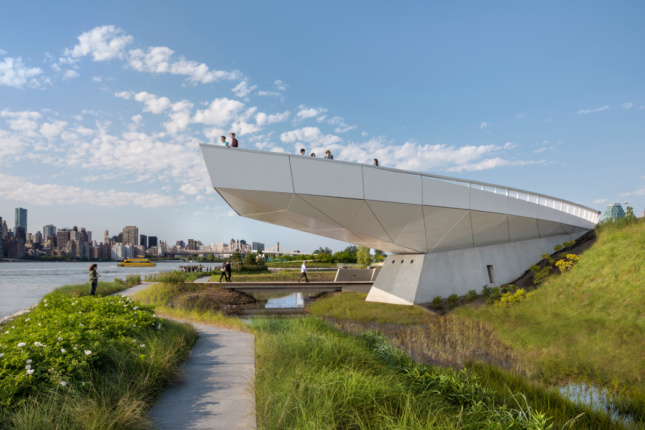
WEISS/MANFREDI was responsible for designing structures for both phases of the park, with Galvin Brothers serving as the general contractors. In Phase 1, that meant the 13,000-square-foot bent-steel pavilion that houses Parks Department offices, restrooms, and a COFFEED cafe at LIC Landing, the park’s ferry dock. Fabrication of the structure and canopies was done by Powell Steel Corporation of Lancaster, Pennsylvania, which permanently closed in 2013. Stainless steel cladding came from Westfield Sheet Metal Works in Kenilworth, New Jersey.
For Phase 2, the towering steel overlook structure (below) was fabricated by Newport Industrial Fabrication in Newport, Maine, while the freestanding precast panel walls were fabricated by Bétons Préfabriqués du Lac (BPDL) in Alma, Quebec.
Furniture
The custom wood–slat lounge chairs and banquette seats and custom precast concrete benches were designed in-house by SWA/Balsley and WEISS/MANFREDI, with galvanized steel framing and Kebony USA–provided Kebonized southern yellow pine. Steel benches with aluminum seat dividers were provided by Landscape Forms and manufactured in Kalamazoo, Michigan, with raw materials mined from within 500 miles of the facility to reduce environmental impact.
Transportation
The park is easily accessible despite its coastal locale. It can be reached via the 7 train’s Vernon Boulevard–Jackson Avenue station; by the Q103 bus via the Vernon Boulevard/49 Avenue stop; by the Long Island Rail Road, which stops at 49-13 Vernon Boulevard; by numerous street-level bike paths; by car; and via the Hunter’s Point South ferry landing.
Vegetation

Plant species were selected for their hardiness and nativity and include juniper trees and a variety of shrubs and grasses for the park’s bioswales. Besides cutting down on maintenance costs, the flora used by SWA/Balsley can thrive on the edge of a briny river, and hosts native fauna. Plants were sourced from nurseries in New York, New Jersey, and Maryland.
Infrastructure
Arup, which was responsible for the structural, civil, and bridge engineering of both phases, oversaw the installation of 7,500 feet of sanitary and storm sewers and 3,700 feet of water main.
Infill and hardscaping
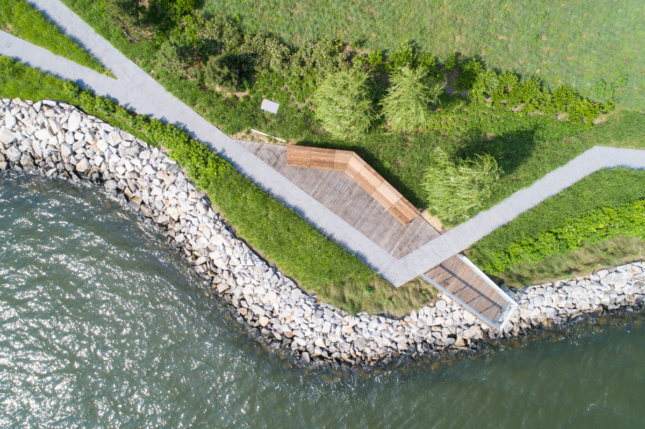
Prior to the park’s construction, the site had been used in the 19th and 20th centuries as a dumping ground for soil excavated from rail-line construction sites around the city, and many portions of the site had since grown wild. To build out and sculpt the shoreline, existing infill was repurposed and moved to the water’s edge. Around the shore, board-formed and precast concrete walls were used to create the harder edges, while Jet Mist and Stony Creek granites mined from Stony Creek, Connecticut, were used for the riprap (below) and to fill in steel gabions.
Art
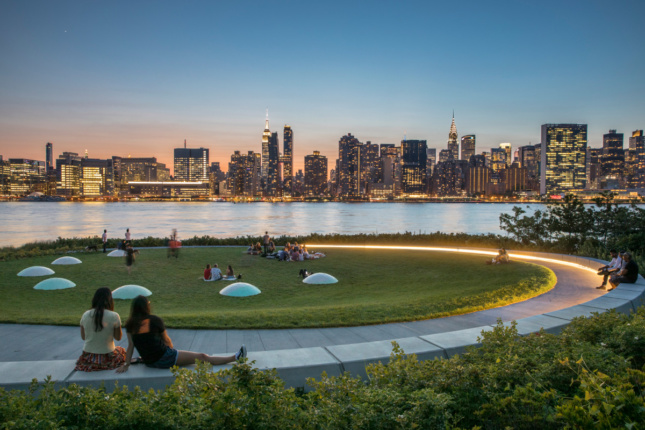
Because this was a city project, the NYCEDC was tasked with appointing an artistic consultant. After a search, Suzanne Randolph Fine Arts was chosen, which in turn picked Nobuho Nagasawa to create a site-specific installation. Seven photoluminescent sculptures resembling different phases of the moon were installed in 2017 in the winding, peninsula-like amphitheater forming a piece titled Luminescence. Each “moon” in the series was cast from Hydrocal, a mixture of plaster and portland cement.
Funding and Labor
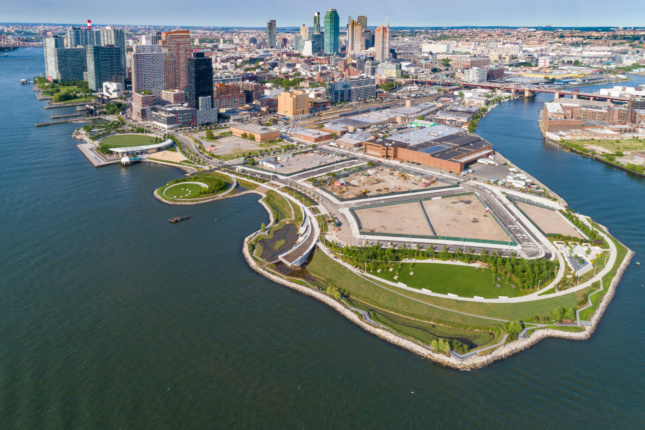
In 2009, the New York City Economic Development Corporation (NYCEDC) selected the project’s developer, TF Cornerstone, and TBA, which brought on WEISS/MANFREDI as collaborators. The project was split into two phases from the beginning. Phase 1 broke ground in January 2011 and opened in August 2013, after the NYCEDC spent $66 million for the 5.5-acre park and an accompanying 3,400 feet of linear roadway. Phase 2, which began construction in November 2015, opened at the end of June 2018, at a cost of $99 million. This 5.5-acre section, which came with another 3,500 linear feet of new roadways, was funded through the NYCEDC as part of Mayor Bill de Blasio’s Housing New York plan, as the park fulfilled the green space requirement of the adjoining housing development and is intended to mitigate flood damage there in the event of a storm surge.
The NYCEDC shepherded the project through two mayoral administrations and hired the LiRo Group to act as construction manager for the build-out, which then subcontracted the actual construction to the Great Neck, Long Island–based Galvin Brothers. The standard design-bid-build process was used for both sections. Park maintenance is handled by the NYC Parks Department.








